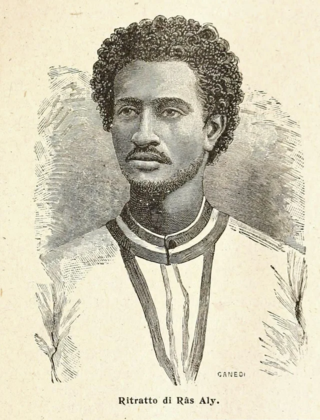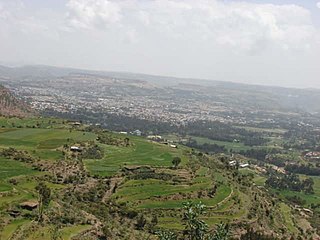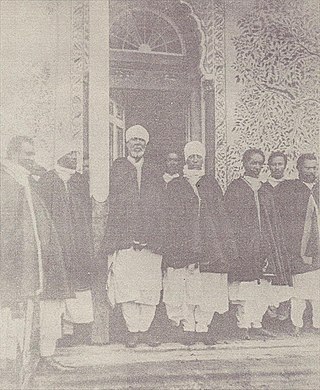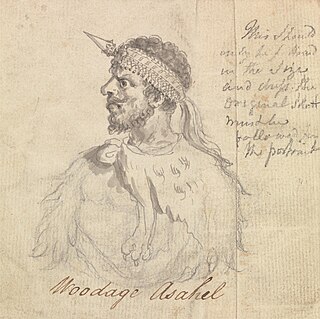Related Research Articles
The Battle of Maychew was the last major battle fought on the northern front during the Second Italo-Abyssinian War. The battle consisted of a failed counterattack by the Ethiopian forces under Emperor Haile Selassie making frontal assaults against prepared Italian defensive positions under the command of Marshal Pietro Badoglio. The battle was fought near Maychew, Ethiopia, in the modern region of Tigray.

The emperor of Ethiopia, also known as the Atse, was the hereditary ruler of the Ethiopian Empire, from at least the 13th century until the abolition of the monarchy in 1975. The emperor was the head of state and head of government, with ultimate executive, judicial and legislative power in that country. A National Geographic article from 1965 called imperial Ethiopia "nominally a constitutional monarchy; in fact [it was] a benevolent autocracy".

Tewodros II was Emperor of Ethiopia from 1855 until his death in 1868. His rule is often placed as the beginning of modern Ethiopia and brought an end to the decentralized Zemene Mesafint.

Ali II of Yejju was Ras of Begemder and the de facto ruler of the Ethiopian Empire. He was a member of a powerful dynasty known as the Yejju, which ruled much of the Ethiopian Empire during the Zemene Mesafint.

Agame was a former province in northern Ethiopia. It includes the northeastern corner of the Ethiopian Empire, borders in Eritrea, Tembien, Kalatta Awlalo and Enderta in the south, and both the Eritrean and Ethiopian Afar lowlands in the east. This relative location of Agame is at the strategic crossroads between the Red Sea and the northern Tigrayan plateau on the other. In pre-1991, Agame had a total area of about 4,889 square kilometres (1,888 sq mi) with an estimated population of 344,800.
The Battle of Derasge was fought on 9 February 1855 between Kassa Hailu's forces and the forces of Wube Haile Maryam, Dejazmatch of Tigray. Kassa won the battle, and two days later was crowned Tewodros II of Ethiopia at the church of Derasge Mariam near Mekane Berhan.

The Zemene Mesafint was a period in Ethiopian history between the mid-18th and mid-19th centuries when the country was ruled by a class of Oromo elite noblemen who replaced Habesha nobility in their courts, making the emperor merely a figurehead. For the most part, the regional lords were tightly related by marriage and constituted a stable ruling elite that prevailed until the mid-20th century. In short, during the Zemene Mesafint, the Emperors from the Solomonic dynasty were reduced to little more than figureheads confined to the capital city of Gondar.

The Irob people are an ethnic group who live in a predominantly highland, mountainous area by the same name in northeastern Tigray Region, Ethiopia. They speak the Saho language. Most of them profess the catholic Christian religion and are mostly farmers. The etymology of the name Irob is debatable, but Irob's elders say that the term comes from the Saho word "Oroba", which means "welcome to our home". The boundaries of Irobland are, to an extent, identical to the Irob woreda; both are bordered by the following areas: Dabri-Mela to the north, Hado to the east, the Afar Region to the east and south, Shoumezana and Gulomakeda to the west, and Saesi Tsaedaemba to the south. The first two neighbors are Saho speakers and predominantly Muslim, the third are Muslim Afars, and the others are Tigrigna-speaking Christians.

Chalacot or Chelekot is a village in the Tigray Region of Ethiopia. Located in the Enderta woreda (district) of the Debub Misraqawi (Southeastern) Zone, 10 kilometers north of Antalo and 17 kilometers south of Mek'ele, the village has an approximate elevation of 2100 meters above sea level. The Central Statistical Agency has not published an estimate for this village's 2005 population.

RasKassa Hailu KS, GCVO, GBE, was a Shewan Amhara nobleman, the son of Dejazmach Haile Wolde Kiros of Lasta, the ruling heir of Lasta's throne and younger brother of Emperor Tekle Giyorgis II, and Tisseme Darge, the daughter of Ras Darge Sahle Selassie, brother of Menelik II's father.

Ethiopia is one of the oldest countries in Africa; the emergence of Ethiopian civilization dates back thousands of years. Abyssinia or rather "Ze Etiyopia" was ruled by the Semitic Abyssinians (Habesha) composed mainly of the Amhara, Tigrayans and the Cushitic Agaw. In the Eastern escarpment of the Ethiopian highlands and more so the lowlands was the home of the Harari/Harla that founded Sultanates such as Ifat and Adal and the Afars. In the central and south were found the ancient Sidama and Semitic Gurage, among others.
Enderta or Inderta is a former historical province of Ethiopia; it is located in the eastern edge of the Tigray highlands. Enderta is bordered on the west by Tembien, on the south and southwest by Lasta and Wag, on the east by denkel, and on the north by Agame and Adwa. Mekelle was formerly the capital of the province. Enderta's local administration of Denkel/Afar up to the edges of Aseb under its jurisdiction seems to have been highly, interlinked with the operation of the salt trade and its taxation system; the entire tasks of salt caravan organization being the responsibility of the bäalgada, title assumed by the governor of Endärta, since at least the Medieval period.

Seyoum Mengesha KBE was an army commander and a member of the royal family of the Ethiopian Empire.

Gugsa Araya Selassie was an army commander and a member of the royal family of the Ethiopian Empire.

The Yejju Oromo are a sub-clan of the Barento branch of Oromo people. They are one of the northernmost communities of Oromo people residing in Ethiopia, along with the Raayyaa.

Wube Haile Maryam of Semien,, also called by his title Dejazmach Wube, Webé; his name is also given in European sources as ‘‘Ubie’’, was one of the major figures of 19th century Ethiopia, during the closing decades of the Zemene Mesafint a period of regional lords vying for power, prestige and territory amid a weakened authority of the emperors.
Tembien is a historic region in Tigray Region and former provinces of Ethiopia. It is a mountainous area of that country. During the reforms in 1994–95, the old provinces were replaced with regions, zones and woredas. The area of the former province is now split over the woredas of Dogua Tembien and Kola Tembien.
Melfa is a tabiya or municipality in the Dogu'a Tembien district of the Tigray Region of Ethiopia and ancient capital of Tembien. The tabia centre is Melfa village itself, located approximately 3 km to the west of the woreda town Hagere Selam.
Betul Haile Maryam was a member of the Semien nobility through his paternal line in the Ethiopian Empire.

This article is about the history of Gondar, a city in Amhara Region of Ethiopia, and previously served as the capital of the Ethiopian Empire from 1632 (at the beginning of Gondarine period to 1855 era.
References
- ↑ Caulk, Richard (October 1972). "Firearms and Princely Power in Ethiopia in the Nineteenth Century". The Journal of African History. 3 (4): 609–630. doi:10.1017/S0021853700011968. S2CID 163096968.